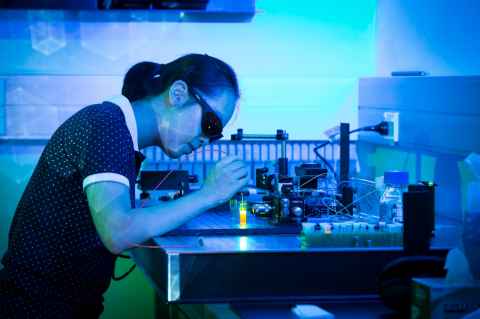Head of Data Science
Fang Ou (Rachel, she/her) believes that her degree in Medical Physics and Imaging Technology gave her early exposure to the level of innovation and ideas that are possible when people of different expertise and experiences come together.

Key facts
Career: Head of Data Science at a start-up company, MantiSpectra and part-time postdoctoral researcher at Eindhoven University of Technology
Programme: Bachelor of Technology Honours (Medical Physics and Imaging Technology), PhD in Physics
“I decided to pursue an Honours degree [BTech, majoring in Medical Physics and Imaging Technology] at the end of my high school studies. Due to its inter-faculty structure, the Medical Physics and Imaging Technology specialisation is naturally interdisciplinary and I saw it as an opportunity to explore different scientific and engineering disciplines. This served me well as I was interested in all sciences (physics, chemistry, biology) and I was not yet ready to choose a particular area to focus on.
“My first scholarship from the University of Auckland was the Faculty of Science Undergraduate Scholarship (2013). It was a great encouragement and reassurance for my efforts in continuing to pursue the Medical Physics and Imaging Technology Honours degree. Subsequently during my undergraduate studies, I also received several University of Auckland Summer Research Scholarships. These opened the doorway to my interest in research and the consideration of continuing to a PhD.
“I like the interdisciplinary nature of the Medical Physics and Imaging Technology courses. They give you exposure to different departments, specialisations and lines of research, which introduces you early on to the level of innovation and ideas that is possible when people of different expertise and experiences come together.
The Honours degree in Medical Physics and Imaging Technology enabled my direct admission into a PhD programme in Physics at the University of Auckland.
"My undergraduate education prepared me well for my interdisciplinary PhD research, which was challenging at times but also a highly enjoyable process. My PhD was not only a journey of academic exploration but also of enormous personal growth.
“My research supervisors had made enormous impacts on my PhD journey. During my PhD, my supervisors have done much more than advising my research queries and teaching me 'the ways' in academia. They have always kept an eye out for opportunities that may benefit their students. Of course, we had to fulfil our obligations as PhD students first, but our supervisors were very supportive of us trying new things. For example, with the support of our supervisors, my fellow PhD students and I had the opportunity to present our research at various national and international conferences, get involved with science outreach for the wider public and schools, and taken on leadership roles within student societies. These in addition to our research have led to a more holistic PhD experience and helped us prepare for a wider range of career options.
“Currently, I am living and working in the Netherlands. I am a part-time postdoctoral researcher at the Eindhoven University of Technology and also Head of Data Science at a start-up company, MantiSpectra, that is commercialising miniaturised chip-based near-infrared spectral sensors for a range of materials analysis applications.
“The University of Auckland is internationally recognised and my PhD qualifications and learnings opened the door to various kinds of job opportunities around the world. My current roles in the Netherlands directly use the research skills developed over the years of my PhD studies and my experience from previous studies at the University of Auckland in optics and photonics.
“I love the interdisciplinary nature of my current projects which enables working with partners from various industries with different backgrounds and expertise. There is also a great potential for miniaturised near-infrared spectral sensors to benefit society and it is exciting to work towards making these traditionally lab-based technology available for use by a wider community.”